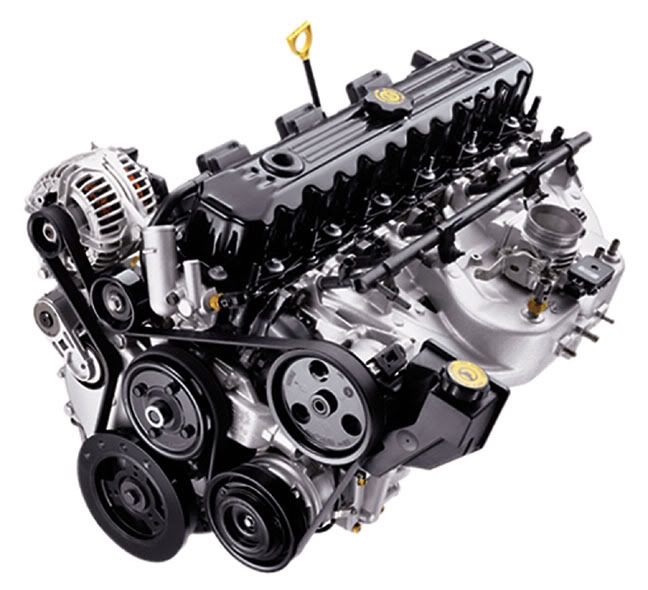Reliable, durable and long-running: These are your top five six-cylinders
The question seemed simple. What is the greatest six-cylinder engine, ever? But with so many factors to consider, personal experience and exposure typically determine your choices. Grew up with a Ford 300-ci inline-six? Boom, there’s your answer. Are you from Rome and favor Alfa Romeos’ songs? You’re inevitably a fan of their Busso (named for its designer, Mr. Giuseppe Busso) V-6 series.
On Monday, we asked you the above question via Facebook. And some clear themes emerged: Longevity, reliability and production numbers. And to a large degree, the answers were much more straightforward than when we asked about V-8s. Matthew Abela got straight to business, “Mopar Slant 6 – the 170, 198 or 225, but especially the 225 for longevity and durability.” While others like Chris Slade didn’t even bother with qualifications, “jeep [sic] 4.0.”
Surprisingly, there were a few notable absences, in particular the Porsche 911’s flat-six (mentioned only once, by Lee J. Cordeiro, and in reference to a recent, water-cooled version installed in the Porsche Cayman, the M97), in use from 1963 through 1998. Also missing were Datsun’s L-series inline-six (also mentioned once) and BMW’s M30 straight-six, which initially produced 150 hp and eventually became the Formula One car-powering M88 that made over 900 hp! Incidentally, both the Porsche flat-six and BMW straight-six were among Ward’s top ten engines of the 20th Century.
It really wasn’t about flash though and perhaps Doug Campbell summarized it best, “The greatest 6-cyl ever? The one that runs like you want it when you wants [sic] it.”
Without further ado, here are your top five greatest six-cylinder engines of all time (in alphabetical order):
AMC I-6 – Andy Ray didn’t have any doubts about his selection, “Clearly, the Jeep 4.0.” And several agreed, including Andy Porter who replied enthusiastically, “AMEN!!! It was originated by Nash Motors.” But the Nash version that was introduced in 1952, also known as the 196 for its displacement in cubic inches, required maintenance more regularly than the subsequent, completely redesigned I-6 built under the American Motors banner.
Originally displacing 232-ci, the straight-six would live through various iterations, becoming the 4.0-L (242-ci) in 1986 and powering the Jeep Cherokee, Grand Cherokee, Wagoneer, Comanche and Wrangler until 2006. Chances are if you drove a Jeep in the mid-‘80s through the mid-‘00s, this engine powered it. Reliability? Maybe Thomas Chiasson said it best, “The 4.0 i6 that stole my heart, for years me and my dad kicked the crap out of it and no problems other then drive train stuff…” At least the engine lasted.
Buick V-6 – The Buick mill was an outlier as the only V-6 making the list. Also known as the “3800” for its displacement (in cubic centimeters) in a later version, the Buick V-6 was first introduced in 1962 and survived in multiple guises until 2008. During that time, Buick actually sold the design to Kaiser-Jeep (who renamed it the Dauntless) and later bought the design back during the ‘70s energy crisis.
Dave Lemmenes picked this six “for durability.” While Rob Hempel felt that the engine speaks for itself, electing to weigh in but not state why he chose as he did. Perhaps because more than 25 million were built by General Motors and Jeep.
Ford I-6 – Debuting in 1941 before America joined WWII’s fray, the Ford inline-six was a production mainstay. However, most people who responded pointed to its fourth generation, which debuted in 1964, and specifically the stroked version that displaced 300-ci and was introduced the following year.
While it was mentioned multiple times and “liked” by still more folks, no one who mentioned the Ford straight-six gave any explanation. We suspect that its 31-year-long production run (from 1965 through 1996) and up to 265 lb. ft. of torque probably have something to do with it.
Jaguar I-6 – Jaguar’s inline-six saw production beginning in 1949 and lasting through 1992. While initially installed in the XK120, the engine powered multiple Le Mans winners, including C-types and D-types, as well as the prototypical British sports car, the XKE.
Only two people (myself being one) mentioned them, but the subsequent “likes” were numerous. It was also the only foreign motor that people responded to in any sizeable number. Additionally, the dual overhead cam design makes early Jaguar XK engines (until 1968) among the most beautiful and distinctive engines ever designed.
Mopar Slant-6 – Brian Wermund recalled proudly, “the slant six, leaning tower of power. Nearly indestructible! Believe me we tried.” Over its 41 years of production, from 1959 until 2000, the slant-six was produced in three varieties, from the Low-G (170-ci), replaced in 1970 by the 198-ci version, which used the same block as the larger Raised-G (225-ci) thereby lowering manufacturing costs.
Known as the “Slant-6” due to its 30 degree cant, its slanted design allowed Chrysler’s designers to lower cars’ overall hood height.
Think we got it wrong? Let us know in the comments below.


